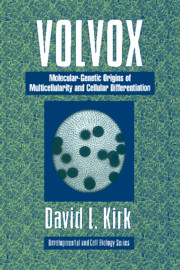 Volvox
Volvox Book contents
- Frontmatter
- Contents
- Preface
- Prologue
- 1 Introduction
- 2 The Volvocales: Many Multicellular Innovations
- 3 Ecological Factors Fostering the Evolution of Volvox
- 4 Cytological Features Fostering the Evolution of Volvox
- 5 Volvox carteri: A Rosetta Stone for Deciphering the Origins of Cytodifferentiation
- 6 Mutational Analysis of the V. carteri Developmental Program
- 7 Molecular Analysis of V. carteri Genes and Development
- Epilogue
- References
- Index
1 - Introduction
Published online by Cambridge University Press: 16 December 2009
- Frontmatter
- Contents
- Preface
- Prologue
- 1 Introduction
- 2 The Volvocales: Many Multicellular Innovations
- 3 Ecological Factors Fostering the Evolution of Volvox
- 4 Cytological Features Fostering the Evolution of Volvox
- 5 Volvox carteri: A Rosetta Stone for Deciphering the Origins of Cytodifferentiation
- 6 Mutational Analysis of the V. carteri Developmental Program
- 7 Molecular Analysis of V. carteri Genes and Development
- Epilogue
- References
- Index
Summary
… we want to understand the mechanics of … development. Today this is one of the central problems in biology. In primitive colonial organisms we see not only the origin of multicellularity, but also the origin of development.
Bonner (1993)In all probability the first objects on this planet worthy of the term “living” were single cells. At present, after nearly 4 billion years of intense competition among millions of kinds of life forms, the vast majority of individuals inhabiting this planet are still unicellular. This is proof enough of the survival value of a unicellular body plan. Nevertheless, all of the conspicuous organisms on the land, in the waters, and in the air above our planet are multicellular organisms with an impressive diversity of differentiated cell types that share the labors of resource accumulation and reproduction in a highly integrated and effective manner.
These conspicuous and highly successful multicellular organisms, with their differentiated cell types and division of labor, have provided biologists some of their most intriguing and persistent puzzles: From what sorts of unicellular ancestors – and why, and when, and how – did multicellular organisms with differentiated cells arise? Such questions tend to fall into two categories: What were the ultimate (e.g., ecological) causes that fostered the evolution of multicellular organisms? What were the proximate (e.g., genetic and cytological) causes that permitted their evolution?
Shunning the intellectual division of labor that has too often characterized biology in this century, in this book we will attempt to examine both the ultimate causes and the proximate causes of the ontogeny and phylogeny of one elegantly simple and beautiful example of multicellularity and cellular differentiation: Volvox, “the fierce roller.”
- Type
- Chapter
- Information
- VolvoxA Search for the Molecular and Genetic Origins of Multicellularity and Cellular Differentiation, pp. 7 - 15Publisher: Cambridge University PressPrint publication year: 1997


